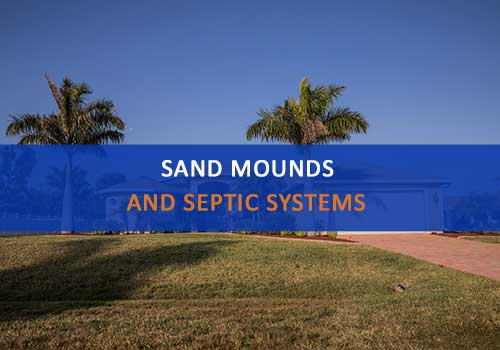Owning a Florida home with a septic system comes with its own set of rules. The same goes for installing them. With part of the filtration relying on natural processes, septic systems require help from their surrounding environment to thrive and efficiently treat wastewater.
Once pushed through your tank, wastewater enters the drain field (or leach field) for its final treatment. This process happens when the wastewater is pushed out of the perforated tubes into the surrounding soil. As it runs down into the water table, the soil filters out any untreated particulates, making the treated water safe to enter the groundwater.
But, what if the water table is too high? This won’t leave enough filtration time before the wastewater enters the groundwater, leading to contamination. In many parts of Florida, this is a very real issue.

How Do Sand Mounds and Septic Systems Work?
For those in areas with high water tables and septic systems, your septic should have been installed with a sand mound.
Septic technicians will build a mound using gravel and sand that your drain field lives on. This allows more time for filtration and the effective treatment of wastewater from the leach field.
Because they are working against gravity, your system will need an effluent pump to push water from your tank into the drain field, which now sits at a higher elevation. The pump will also only allow the amount of water your drain field can handle within a given timeframe.
Sand mounds offer solutions to homes closer to the bedrock and groundwater than acceptable — a category many Florida homeowners fall into.
Caring Sand Mounds
Like everything septic, maintenance is key to avoiding repairs and issues. And sand mounds are no exception to this rule.
Divert Storm Water
The drain field and surrounding area have enough water on their hands. You’ll want to make sure to divert stormwater away from that area to not overwhelm the filtration zone. Point storm drains in opposite directions and create runoff areas away from your septic system.
If this is an area prone to flooding during a storm, make sure to let your technician know before installation.
Manage Water Use
Too much household water can also impede your system.
If too much water enters the septic system at one time, your tank cannot handle the influx and pushes the water out before its initial treatment. With your drain field already taking excess water, the system and soil aren’t prepared to handle wastewater that needs additional treatment and filtration.
It’s essential to manage your water usage. If you just ran a few loads of laundry, wait to shower for a bit. Don’t run the dishwasher and washer at the same time. A little balance can go a long way in helping your septic systems do its job.
Know Where Your Septic Parts are in Your Yard
While the location of your sand mound may be prominent, know where the drain field pipes and septic tank are as well. Not only should no heavy machinery or lawn decorations be placed on top, but you should avoid certain trees and shrubs as well.
Keep Your Sand Mound and Septic Healthy
Sand mounds help your septic function in less than ideal settings. It allows for flexibility and function — so why wouldn’t you do everything you can to keep your system working efficiently?
A little knowledge and maintenance go a long way to keeping your septic running efficiently.

